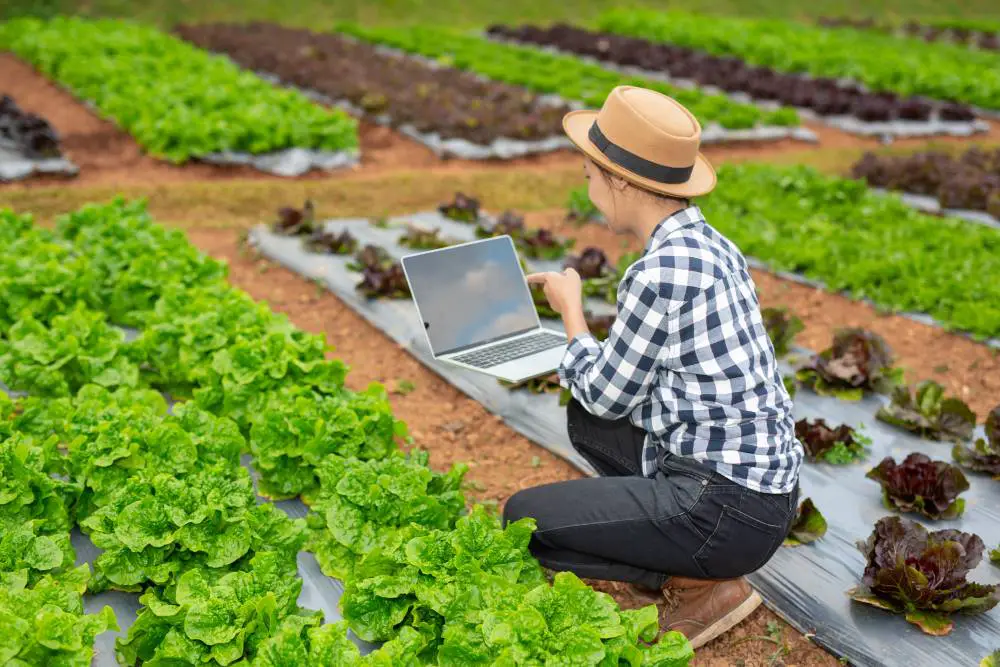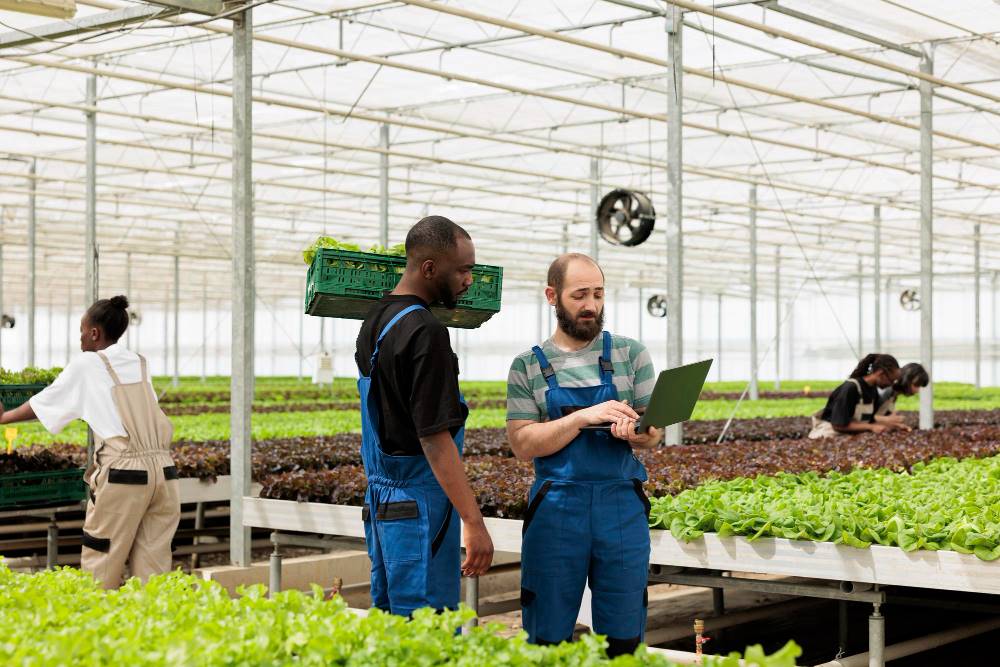In an era of burgeoning populations and environmental challenges, ensuring food security while minimizing ecological impact has become a global imperative. Enter the realm of smart agriculture, where the integration of cutting-edge technologies such as Internet of Things (IoT) and Artificial Intelligence (AI) is transforming traditional farming practices into sustainable, high-efficiency systems. This article explores how these innovations are reshaping sustainable greenhouse farming technology, encompassing advancements in areas such as irrigation management, crop monitoring, and energy efficiency. Moreover, it recognizes the significance of components like greenhouse ventilation systems, highlighting the multifaceted nature of modern agricultural solutions.
Optimizing Growing Environments with IoT
Greenhouses have long been valued for their ability to provide controlled growing environments, but with the integration of IoT technology, this control reaches new heights of precision. Through strategically placed sensors and automated systems, IoT enables real-time monitoring and adjustment of key environmental factors within the greenhouse.
Read also: 3 Reasons to Give IoT a Try as a Hobby
1) Temperature Regulation
IoT-enabled thermostats and sensors ensure that the temperature remains within the optimal range for plant growth. Automated climate control systems adjust heating and cooling as needed, promoting healthy plant development.
2) Humidity Control
Maintaining proper humidity levels is crucial for preventing mold and disease while promoting optimal plant growth. IoT sensors monitor humidity levels and trigger ventilation and irrigation systems to maintain ideal conditions.
3) CO2 Management
Carbon dioxide (CO2) is essential for photosynthesis, and IoT technology ensures that plants receive the right amount. Sensors track CO2 levels and adjust ventilation to optimize concentrations, enhancing photosynthetic efficiency.
4) Lighting Optimization
In regions with limited sunlight, supplemental lighting is essential for year-round production. IoT-controlled lighting systems adjust intensity and duration based on real-time data, providing plants with the optimal light spectrum for photosynthesis.
5) Water Management
Efficient irrigation is vital for conserving water and promoting healthy root development. IoT-enabled systems monitor soil moisture levels and deliver water directly to the roots as needed, minimizing waste.
6) Crop-Specific Optimization
Different crops have unique environmental requirements, and IoT technology allows for tailored growing conditions. By customizing temperature, humidity, lighting, and irrigation settings, farmers can optimize the growing environment for each crop.
Enhancing Crop Monitoring and Management with AI
AI technology is revolutionizing crop monitoring and management in greenhouse farming, offering farmers unprecedented insights into plant health and growth.
1) Early Detection of Issues
AI-powered imaging systems, such as spectral cameras and LiDAR, provide detailed data on plant health and development. By analyzing subtle changes in plant color, texture, and structure, AI algorithms can detect signs of stress, disease, or nutrient deficiencies at an early stage. This early detection allows farmers to take proactive measures to address issues before they escalate, minimizing crop loss and maximizing yield.
2) Precision Pest Management
AI algorithms can analyze data from sensors and imaging systems to identify signs of pest infestations in their early stages. By detecting subtle changes in plant behavior or the presence of pests themselves, AI can provide targeted recommendations for pest control measures. This precision approach reduces the need for broad-spectrum pesticides, minimizing environmental impact and preserving beneficial insect populations.
3) Optimizing Nutrient Management
AI algorithms can analyze soil and plant data to optimize nutrient management strategies. By correlating nutrient levels with plant growth and performance, AI can recommend precise fertilizer applications tailored to the specific needs of each crop. This targeted approach maximizes nutrient uptake, minimizes waste, and promotes healthy plant growth.
4) Predictive Analytics
AI-powered predictive analytics can forecast crop yields based on historical data, environmental conditions, and crop health indicators. By predicting future yields with accuracy, farmers can make informed decisions regarding planting schedules, resource allocation, and market planning. This predictive capability enables farmers to optimize production, reduce waste, and maximize profitability.
5) Continuous Improvement
AI systems can learn and adapt over time, continually improving their accuracy and effectiveness. By analyzing feedback data and adjusting algorithms accordingly, AI can enhance its ability to detect and respond to crop-related issues. This continuous improvement cycle ensures that AI-powered crop monitoring and management systems remain effective and relevant in the ever-changing greenhouse environment.
Read also: What is Cognitive Automation, Its Benefits and Applications
Promoting Sustainability through Efficient Resource Management
Efficient resource management is at the core of sustainable greenhouse farming practices, and IoT technology plays a crucial role in optimizing resource usage.
1) Water Conservation
Water is a precious resource, and smart irrigation systems equipped with IoT sensors help minimize water waste by delivering water directly to the roots of plants only when needed. Soil moisture sensors monitor moisture levels, allowing for precise irrigation scheduling and preventing overwatering.
2) Energy Efficiency
Greenhouse operations require significant energy inputs for heating, cooling, and lighting. IoT-enabled climate control systems optimize energy usage by adjusting heating and cooling systems based on real-time environmental conditions. Additionally, energy-efficient lighting systems equipped with IoT controls ensure that plants receive the right amount of light for photosynthesis while minimizing electricity consumption.
3) Waste Reduction
Smart greenhouse systems aim to minimize waste at every stage of the production process. From precision irrigation and nutrient management to optimized harvesting techniques, IoT technology helps reduce waste and maximize resource efficiency. Additionally, IoT-enabled monitoring systems track resource usage and identify areas for improvement, allowing farmers to implement targeted strategies to further reduce waste and enhance sustainability.
4) Carbon Footprint Reduction
By optimizing resource usage and reducing waste, smart greenhouse systems contribute to the overall reduction of carbon emissions associated with agricultural production. IoT technology allows farmers to monitor and analyze their carbon footprint, identify areas for improvement, and implement measures to minimize environmental impact.
5) Long-term Sustainability
Sustainable greenhouse farming is not just about maximizing short-term productivity; it’s also about ensuring the long-term health and viability of agricultural systems. By promoting efficient resource management through IoT technology, greenhouse farmers can build resilient and sustainable farming operations that can thrive for generations to come.
Empowering Precision Agriculture with Data-driven Insights
Data-driven insights are transforming agriculture, empowering farmers with the information needed to optimize production and sustainability. By harnessing the power of sustainable greenhouse farming technology, farmers can make informed decisions that maximize yield while minimizing environmental impact.
1) Yield Forecasting
Predictive analytics leverage historical data and environmental factors to forecast crop yields accurately. This allows farmers to plan planting schedules, allocate resources efficiently, and maximize yield potential.
2) Crop Monitoring
IoT sensors provide real-time data on plant health and growth parameters, such as temperature, humidity, and nutrient levels. AI algorithms analyze this data to detect early signs of stress or disease, enabling proactive intervention to maintain crop health.
3) Inventory Management
Data analytics facilitate efficient inventory tracking and management, ensuring timely harvests and minimizing waste. Farmers can monitor crop growth stages and adjust harvesting schedules to meet market demand.
4) Market Analysis
AI algorithms analyze market trends and consumer preferences to inform production decisions and marketing strategies. By aligning production with market demand, farmers can optimize profitability and reduce the risk of surplus or undersupply.
5) Continuous Improvement
Data-driven insights enable farmers to analyze performance metrics and identify areas for optimization. By continuously adapting and refining farming practices, farmers can improve efficiency and sustainability over time.
Fostering Innovation and Collaboration in the Agricultural Sector
Innovation and collaboration are essential drivers of progress in the agricultural sector, particularly in the realm of smart greenhouse farming.
1) Cross-disciplinary Collaboration
Bringing together experts from diverse fields such as agronomy, engineering, data science, and environmental science fosters innovation and accelerates the development of cutting-edge technologies. Collaborative efforts enable the integration of multidisciplinary perspectives, leading to more holistic solutions to complex agricultural challenges.
2) Open-source Platforms
Open-source software platforms provide a collaborative space for researchers, developers, and farmers to share knowledge, data, and tools. By fostering an open and collaborative ecosystem, these platforms facilitate innovation and accelerate the adoption of sustainable agricultural practices.
3) Knowledge Sharing and Best Practices
Collaboration networks enable farmers to share best practices, lessons learned, and success stories. By learning from each other’s experiences, farmers can overcome challenges more effectively, optimize production techniques, and improve overall farm performance.
4) Research and Development Partnerships
Collaborations between academia, industry, and government agencies drive research and development in agricultural technologies. By pooling resources and expertise, these partnerships accelerate innovation, leading to the development of new technologies and practices that enhance productivity, sustainability, and resilience in agriculture.
5) Policy and Regulatory Support
Governments play a crucial role in fostering innovation and collaboration in the agricultural sector through supportive policies and regulations. By providing incentives for research and development, promoting technology adoption, and fostering collaboration between stakeholders, policymakers can create an enabling environment for innovation and growth in agriculture.
6) Community Engagement
Engaging with local communities and stakeholders is essential for building trust, fostering cooperation, and ensuring the successful implementation of agricultural innovations. By involving farmers, consumers, and other stakeholders in the innovation process, agricultural initiatives can better meet the needs and preferences of the communities they serve.
Read also: The Benefits of Business Automation
Frequently Asked Questions (FAQs)
1) How is AI used in sustainable agriculture?
AI helps farmers make better decisions by analyzing data from sensors and drones. It can predict crop yields, detect pests and diseases early, and optimize resource usage like water and fertilizer.
2) What is the role of AI and IoT in agriculture?
AI and IoT help farmers monitor crops and fields in real-time. IoT sensors collect data on soil moisture, temperature, and more, while AI analyzes this data to make farming more efficient. They also automate tasks like irrigation and pest control.
3) How can AI contribute to sustainability?
AI can help reduce waste and environmental impact in agriculture. By optimizing resource usage, predicting crop yields, and detecting problems early, AI helps farmers grow more food with fewer resources and less harm to the environment.
Read also: How Technology Is Transforming Golf Turf Management
Conclusion
As the global population continues to grow, the need for sustainable food production systems has never been more urgent. Greenhouse farming, powered by IoT and AI technologies, offers a promising solution to this challenge. By optimizing growing environments, enhancing crop monitoring and management, and promoting efficient resource management, smart greenhouse systems enable farmers to produce more food with fewer resources, all while minimizing environmental impact. With continued innovation and collaboration, we can build a more resilient and sustainable greenhouse farming technology for generations to come.


